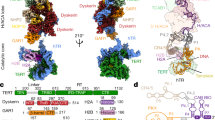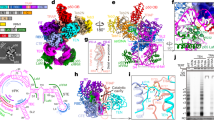Abstract
Telomeric ends of chromosomes, which comprise noncoding repeat sequences of guanine-rich DNA, are fundamental in protecting the cell from recombination and degradation1. Disruption of telomere maintenance leads to eventual cell death, which can be exploited for therapeutic intervention in cancer. Telomeric DNA sequences can form four-stranded (quadruplex) structures2,3,4, which may be involved in the structure of telomere ends5. Here we describe the crystal structure of a quadruplex formed from four consecutive human telomeric DNA repeats and grown at a K+ concentration that approximates its intracellular concentration. K+ ions are observed in the structure. The folding and appearance of the DNA in this intramolecular quadruplex is fundamentally different from the published Na+-containing quadruplex structures2,4,6. All four DNA strands are parallel, with the three linking trinucleotide loops positioned on the exterior of the quadruplex core, in a propeller-like arrangement. The adenine in each TTA linking trinucleotide loop is swung back so that it intercalates between the two thymines. This DNA structure suggests a straightforward path for telomere folding and unfolding, as well as ways in which it can recognize telomere-associated proteins.
This is a preview of subscription content, access via your institution
Access options
Subscribe to this journal
Receive 51 print issues and online access
$199.00 per year
only $3.90 per issue
Buy this article
- Purchase on Springer Link
- Instant access to full article PDF
Prices may be subject to local taxes which are calculated during checkout




Similar content being viewed by others
References
Hackett, J. A., Feldser, D. M. & Greider, C. W. Telomere dysfunction increases mutation rate and genomic instability. Cell 106, 275–286 (2001)
Smith, F. W. & Feigon, J. Quadruplex structure of oxytricha telomeric DNA oligonucleotides. Nature 356, 164–168 (1992)
Wang, Y. & Patel, D. J. Guanine residues in d(T2AG3) and d(T2G4) form parallel-stranded potassium cation stabilized G-quadruplexes with anti glycosidic torsion angles in solution. Biochemistry 31, 8112–8119 (1992)
Horvath, M. P. & Schultz, S. C. DNA G-quartets in a 1.86 Å resolution structure of an Oxytricha nova telomeric protein–DNA complex. J. Mol. Biol. 310, 367–377 (2001)
Schaffitzel, C. et al. In vitro generated antibodies specific for telomeric guanine-quadruplex DNA react with Stylonychia lemnae macronuclei. Proc. Natl Acad. Sci. USA 98, 8572–8577 (2001)
Wang, Y. & Patel, D. J. Solution structure of the human telomeric repeat d[AG3(T2AG3)3] G-tetraplex. Structure 1, 263–282 (1993)
Wright, W. E. et al. Normal human chromosomes have long G-rich telomeric overhangs at one end. Genes Dev. 11, 2801–2809 (1997)
Simonsson, T. G-quadruplex DNA structures—variations on a theme. Biol. Chem. 382, 621–628 (2001)
Phillips, K., Dauter, Z., Murchie, A. I., Lilley, D. M. & Luisi, B. The crystal structure of a parallel-stranded guanine tetraplex at 0.95 Å resolution. J. Mol. Biol. 273, 171–182 (1997)
Mergny, J.-L. & Hélène, C. G-quadruplex DNA: a target for drug design. Nature Genet. 4, 1366–1367 (1998)
Bearss, D. J., Hurley, L. H. & Von Hoff, D. D. Telomere maintenance mechanisms as a target for drug development. Oncogene 19, 6632–6641 (2000)
Gowan, S. M. et al. A G-Quadruplex-interactive potent small-molecule inhibitor of telomerase exhibiting in vitro and in vivo antitumor activity. Mol. Pharmacol. 61, 1154–1162 (2002)
Read, M. A. et al. Structure-based design of selective and potent G quadruplex-mediated telomerase inhibitors. Proc. Natl Acad. Sci. USA 98, 4844–4849 (2001)
Sun, H., Yabuki, A. & Maizels, N. A human nuclease specific for G4 DNA. Proc. Natl Acad. Sci. USA 98, 12444–12449 (2001)
Li, J.-L. et al. Inhibition of the Bloom's and Werner's syndrome helicases by G-quadruplex interacting ligands. Biochemistry 40, 15194–15202 (2001)
Smith, F. W., Schultze, P. & Feigon, J. Solution structures of unimolecular quadruplexes formed by oligonucleotides containing Oxytricha telomere repeats. Structure 3, 997–1008 (1995)
Balagurumoorthy, P. B. & Brahmachari, S. K. Structure and stability of human telomeric sequence. J. Biol. Chem. 269, 21858–21869 (1994)
Read, M. A. et al. Molecular modeling studies on G-quadruplex complexes of telomerase inhibitors: Structure–activity relationships. J. Med. Chem. 42, 4538–4546 (1999)
Harrison, R. J., Gowan, S. M., Kelland, L. R. & Neidle, S. Human telomerase inhibition by substituted acridine derivatives. Bioorg. Med. Chem. Lett. 9, 2463–2468 (1999)
Han, H., Langley, D. R., Rangan, A. & Hurley, L. H. Selective interactions of cationic porphyrins with G-quadruplex structures. J. Am. Chem. Soc. 123, 8902–8913 (2001)
Riou, J. F. et al. Cell senescence and telomere shortening induced by a new series of specific G-quadruplex DNA ligands. Proc. Natl Acad. Sci. USA 99, 2672–2677 (2002)
Koeppel, F. et al. Ethidium derivatives bind to G-quartets, inhibit telomerase and act as fluorescent probes for quadruplexes. Nucleic Acids Res. 29, 1087–1096 (2001)
Fedoroff, O. Y. et al. NMR-based model of a telomerase-inhibiting compound bound to G-quadruplex DNA. Biochemistry 37, 12367–12374 (1998)
Read, M. A. & Neidle, S. Structural characterization of a guanine–quadruplex ligand complex. Biochemistry 39, 13422–13432 (2000)
Han, H., Cliff, C. L. & Hurley, L. H. Accelerated assembly of G-quadruplex structures by a small molecule. Biochemistry 38, 6981–6986 (1999)
Otwinowski, Z. M. & Minor, W. Processing of X-ray diffraction data collected in oscillation mode. Methods Enzymol. 276, 307–326 (1997)
Brünger, A. T. et al. Crystallography & NMR system: A new software suite for macromolecular structure determination. Acta. Crystallogr. D 54, 905–921 (1998)
Sheldrick, G. M. & Schneider, T. R. SHELX-97: high-resolution refinement. Methods Enzymol. 276, 319–343 (1997)
Cambilleau, C. & Horjales, E. TOM:A FRODO subpackage for protein-ligand fitting with interactive energy minimisation. J. Mol. Graphics 5, 175–177 (1987)
Acknowledgements
We are grateful to Cancer Research UK for support of these studies, and various colleagues for discussions, especially M. Read, J. Harrison, G. Chessari and L. Pearl. We thank M. Roe and the ID14 beamline staff for assistance with data collection.
Author information
Authors and Affiliations
Corresponding author
Ethics declarations
Competing interests
The authors declare that they have no competing financial interests.
Supplementary information
Rights and permissions
About this article
Cite this article
Parkinson, G., Lee, M. & Neidle, S. Crystal structure of parallel quadruplexes from human telomeric DNA. Nature 417, 876–880 (2002). https://doi.org/10.1038/nature755
Received:
Accepted:
Published:
Issue Date:
DOI: https://doi.org/10.1038/nature755
This article is cited by
-
Structure–activity relationships for the G-quadruplex-targeting experimental drug QN-302 and two analogues probed with comparative transcriptome profiling and molecular modeling
Scientific Reports (2024)
-
Dynamic interaction of BRCA2 with telomeric G-quadruplexes underlies telomere replication homeostasis
Nature Communications (2022)
-
Engineering DNA quadruplexes in DNA nanostructures for biosensor construction
Nano Research (2022)
-
Facile induction and stabilization of intramolecular antiparallel G-quadruplex of d(TTAGGG)n on interaction with triazine-2-imidazole ethyl amine compound and its Cu(II), Zn(II) complexes under no-salt conditions
Journal of Chemical Sciences (2022)
Comments
By submitting a comment you agree to abide by our Terms and Community Guidelines. If you find something abusive or that does not comply with our terms or guidelines please flag it as inappropriate.



